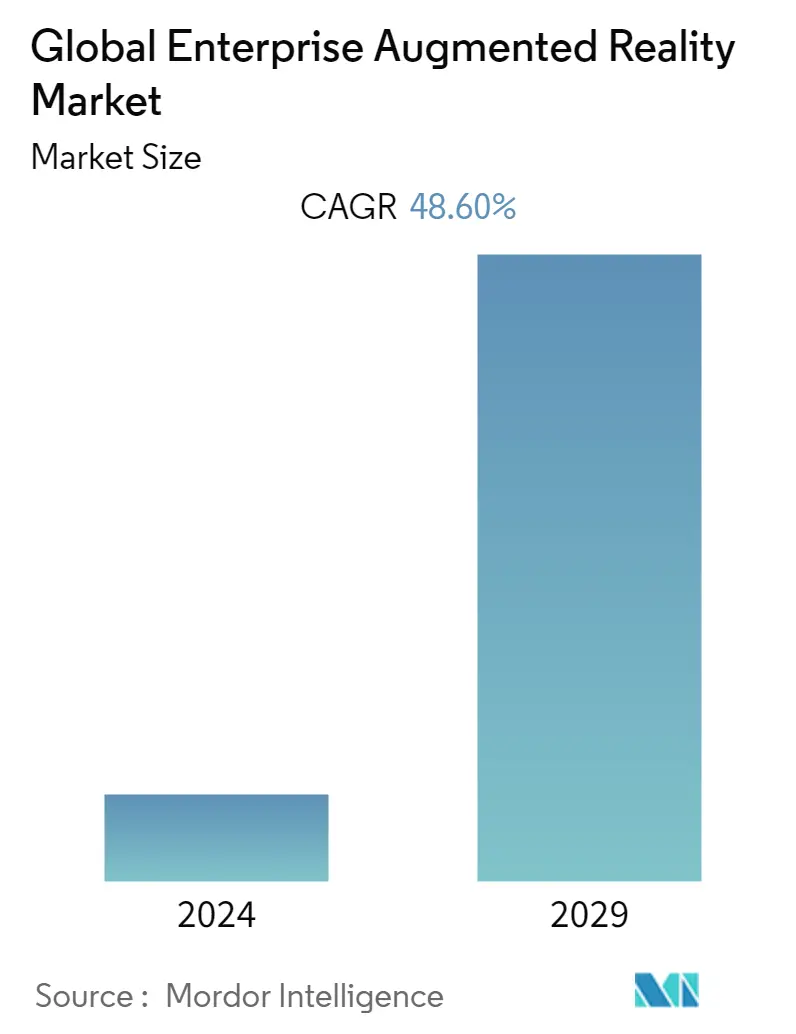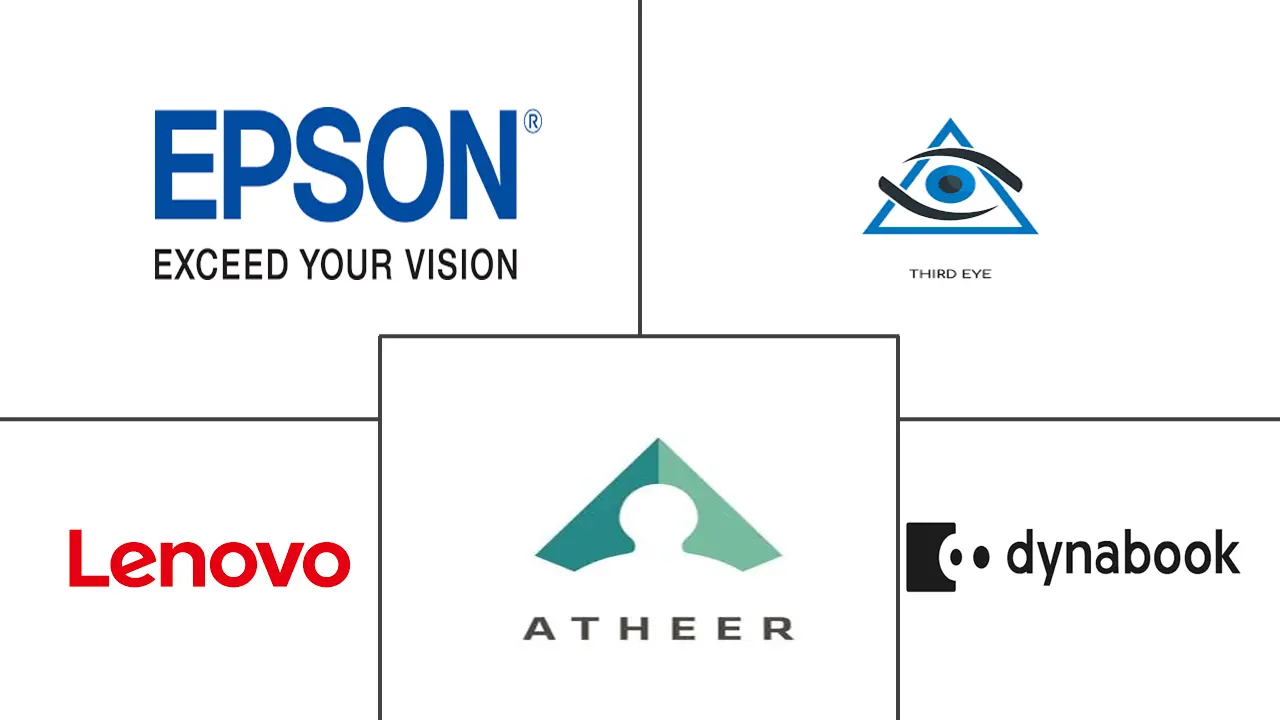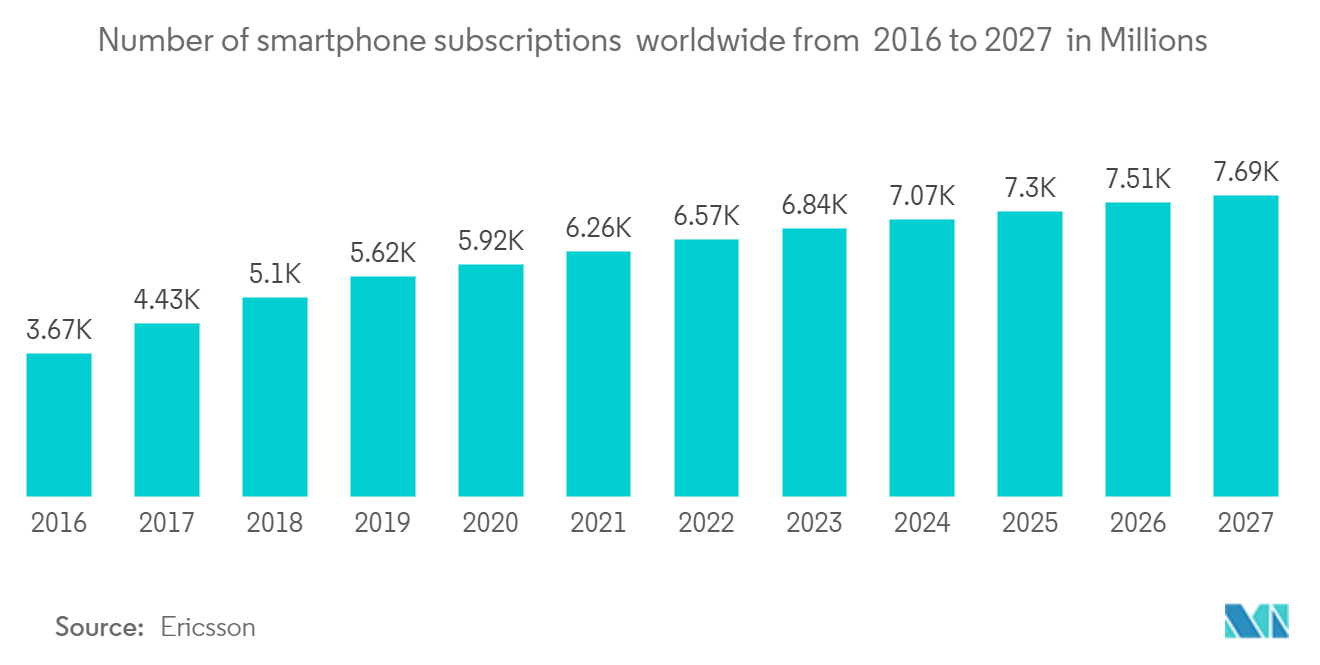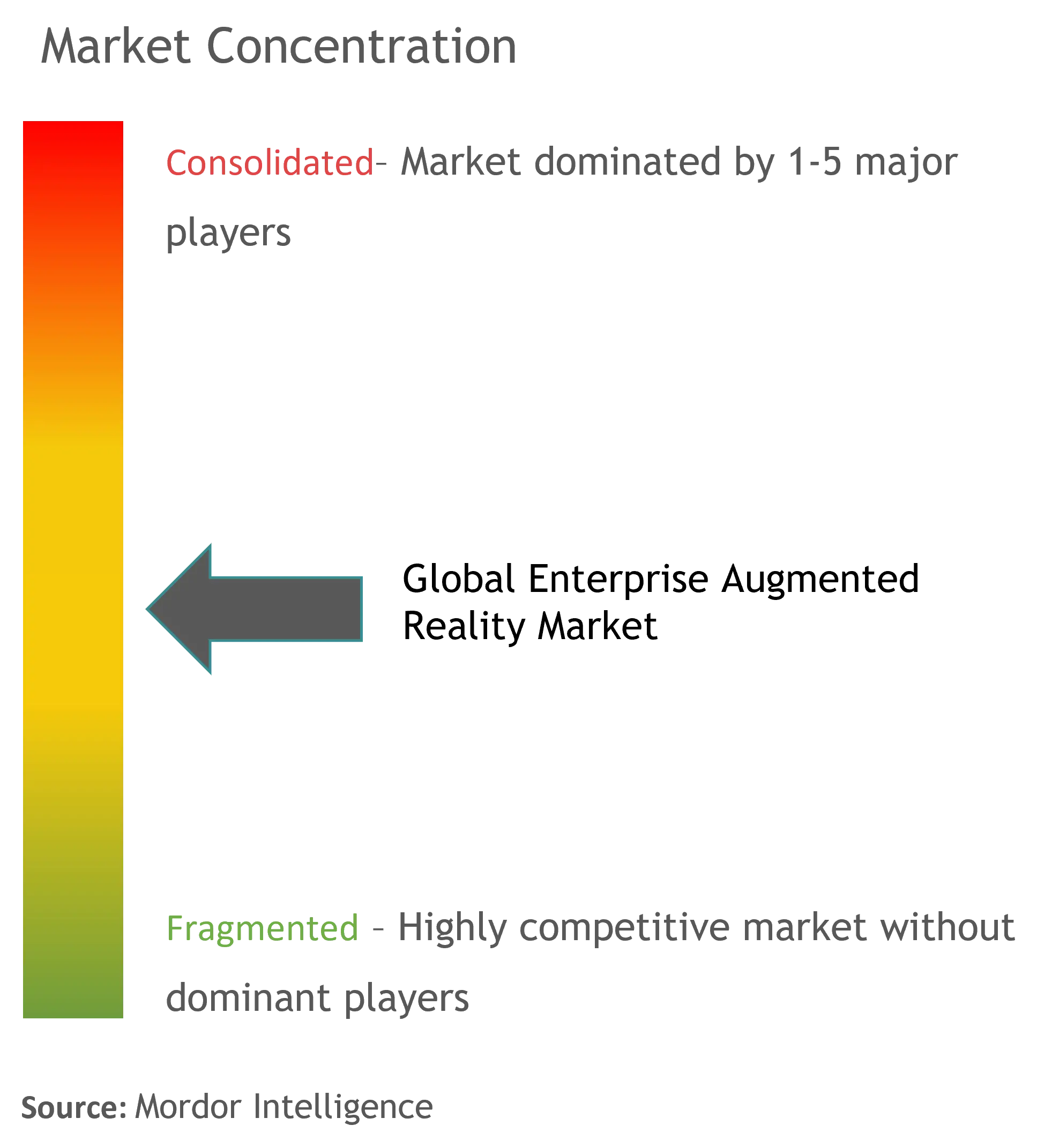Enterprise Augmented Reality Market Size

| Study Period | 2019 - 2029 |
| Base Year For Estimation | 2023 |
| CAGR | 48.60 % |
| Fastest Growing Market | Asia-Pacific |
| Largest Market | North America |
| Market Concentration | Medium |
Major Players
*Disclaimer: Major Players sorted in no particular order |
Enterprise Augmented Reality Market Analysis
United States Contract Manufacturing Services Market is expected to grow at a CAGR of 25.1% over the forecast period (2022-2027). The Evolution of service offerings has enabled organizations to rely on contract manufacturers for their production needs to increase. Challenges faced due to outsourcing manufacturing to Asian countries have played a key role in prompting organizations to rely on contract manufacturers. These are driving factors for the growth of the United States Contract Manufacturing Services Market.
- The market is driven by a growing emphasis on pharmaceutical drug discovery and manufacturing outsourcing. The country is increasing the use of scientific exploration of disease mechanisms leading to the discovery and development of agents. Pre-clinical testing is an important stage in pharmaceutical research. Several tests are performed to determine whether a drug is ready for clinical trials at this stage.
- The food processing and manufacturing sector has witnessed significant growth due to the wide presence of major food manufacturers and important innovations in food & beverage in the country.
- Increasing awareness of the benefits of contract manufacturing localization, such as a reduction in lead time, which is the most important factor for fast-moving personal care products, is expected to boost the market growth.
- There has been a shift in manufacturing firms' preferences toward local contractors, as beverage contract bottling and filling offers several benefits. For starters, it lowers the manufacturers' operational and labor costs as the primary driver of market growth.
- Due to a nationwide lockdown, the COVID-19 pandemic delivered a major blow to the nation's Contract Manufacturing Services distribution system. For instance, In March 2020, many US beverage makers, like Coca-Cola, temporarily suspended production across the country's manufacturing facilities.
Enterprise Augmented Reality Market Trends
This section covers the major market trends shaping the Enterprise Augmented Reality Market according to our research experts:
Demand for Mobile-base AR is Expected to Witness Significant Growth
- Due to its immersive and interactive technology, augmented reality is becoming ideal for mobile gaming. Furthermore, mobile games are the most popular AR category in app stores. Aside from previously released AR mobile games that are still popular, such as Pokémon Go and Ingress, many other new additions to the genre are being made by vendors in the global market.
- Users anticipate more than just a visual representation of their reality. As a result, companies developing AR mobile applications use sensors, GPS, compass, and smart device cameras to provide users with augmented reality in the form of an image and a nugget of information.
- Mobile Augmented Reality Application is a mobile application that integrates built-in components into a mobile phone and offers a customized application to provide reality-based services and functions. According to the GSMA, the number of smartphone subscribers in North America is expected to reach 328 million by 2025 and may witness an increase in the penetration rates of smartphones at 86% and the internet at 80%, consequently plunging the adoption of MARA, which in turn is fostering enterprise AR adoption.
- The best-augmented reality (AR) software, hardware, and 5G networks are combined. For instance, Spatial, the US-based holographic collaboration platform, Neal, the mobile AR headset manufacturer, and Qualcomm Technologies are joining forces with LG Uplus, KDDI, and Deutsche Telekom, respectively, to accelerate mass-market adoption of AR collaboration.
- Further, AR has witnessed an increasing implementation in existing applications and platforms, including gamification for customer engagement, AR applications, social media-based marketing, and enterprise collaboration for unified workplace communications. In addition, game developers are anticipated to use AR as a differentiator that could encourage new downloads.

North America to hold largest Market share
- The North American AR market has been expected to expand significantly over the forecast period, owing to numerous vendors investing heavily in market innovation. A recent survey by TechSee Augmented Vision Ltd. shows that more than 68 million people in the United States are already using AR, which is supposed to grow over the next several years, with the global AR market prophesied to be worth over USD 72 billion by 2024.
- United States is expected to be one of the most innovative AR markets in the world. Most companies developing this technology are based in the United States. The region's high technology exposure and easy availability of smart devices have resulted in a strong AR market. Microsoft's augmented reality (AR) product, Hololens, was first released in the United States and Canada, receiving a positive response from consumers.
- Furthermore, the region has the highest adoption rate of smart devices, particularly smart watches and glasses. Because smart devices, especially smartphones, play a significant role in the development of the AR market, the region presents an important opportunity for the growth of the market studied over the forecast period.
- Rising investments in immersive technologies are boosting demand for the technology in the region. For instance, the US government is keenly encouraging the adoption of immersive technologies, strengthening the region's hold on the augmented reality market.
- As many customers cannot get to physical stores amid the coronavirus pandemic, exploring augmented reality (AR) initiatives for retail is high in the region. For instance, Threekit, a product visualization software provider based in Chicago, announced introducing a configurable AR feature, enabling shoppers to see and customize product variations in augmented reality.

Enterprise Augmented Reality Industry Overview
The Global Enterprise Augmented Reality Market is competitive with diverse firms of different sizes. This market is anticipated to encounter several partnerships, mergers, and acquisitions as organizations continue to invest strategically in offsetting the present slowdowns they are experiencing. The market comprises key solutions and service providers, such as Epson America Inc, ThirdEye, Lenovo Corporation, Atheer Inc., and Dynabook Americas Inc.
- February 2021 - Epson provider of the augmented smart glass platform, has announced a partnership with spinar America to deliver Augmented Reality Remote Assistance through Zoom for Hybrid Work Environments.
Enterprise Augmented Reality Market Leaders
-
Epson America Inc. (Seiko Epson Corporation)
-
ThirdEye
-
Lenovo Corporation
-
Atheer Inc.
-
Dynabook Americas Inc.
*Disclaimer: Major Players sorted in no particular order

Enterprise Augmented Reality Market News
- May 2022 - ThirdEye, an Augmented Reality & Artificial Intelligence (AR/AI) solution, has launched a decentralized Augmented Reality (AR) 3D social network for consumers, where they have control over their data and will be able to place virtual AR objects in the real world
- November 2021 - Qualcomm and Lenovo have announced a partnership to launch a new augmented reality by combining the Snapdragon Spaces XR Developer Platform and the ThinkReality A3 smart glasses to build AR apps, where Developers can use the platform to create new 3D applications for AR glasses or add AR features to existing Android smartphone applications.
Enterprise Augmented Reality Market Report - Table of Contents
1. INTRODUCTION
- 1.1 Study Assumptions and Market Definitions
- 1.2 Scope of the Study
2. RESEARCH METHODOLOGY
3. EXECUTIVE SUMMARY
4. MARKET INSIGHTS
- 4.1 Market Overview
-
4.2 Industry Attractiveness-Porter's Five Force Analysis
- 4.2.1 Bargaining Power of Suppliers
- 4.2.2 Bargaining Power of Buyers/Consumers
- 4.2.3 Threat of New Entrants
- 4.2.4 Threat of Substitute Products
- 4.2.5 Intensity of Competitive Rivalry
- 4.3 Industry Stakeholder Analysis
- 4.4 Impact of COVID-19 on the Industry
5. MARKET DYNAMICS
-
5.1 Market Drivers
- 5.1.1 Higher Effectiveness and Efficacy of AR Applications
- 5.1.2 High Demand for Mobile-based Augmented Reality
-
5.2 Market Challenges
- 5.2.1 Need For Higher Bandwidth and Susceptibility to External Environmental
6. Market Segmentation
-
6.1 By End-user
- 6.1.1 Retail and E-commerce
- 6.1.2 Education (E-learning)
- 6.1.3 Industrial
- 6.1.4 Automotive and Aerospace
- 6.1.5 Professional Services
- 6.1.6 Other End-user Applications (Energy, Public Safety,Agriculture, etc.)
-
6.2 By Geography
- 6.2.1 North America
- 6.2.2 Europe
- 6.2.3 Asia-Pacific
- 6.2.4 Rest of the World (Latin America and Middle East & Africa)
7. Competitive Landscape
-
7.1 Company Profiles
- 7.1.1 Dynabook Americas Inc.
- 7.1.2 Epson America Inc. (Seiko Epson Corporation)
- 7.1.3 ThirdEye
- 7.1.4 Lenovo Corporation
- 7.1.5 Atheer Inc.
- 7.1.6 Rokid Inc.
- 7.1.7 Vuforia (PTC Inc.)
- 7.1.8 Nextech AR Solutions Corp
- 7.1.9 Librestream
- 7.1.10 Vuzix Corporation
- 7.1.11 Dalux
- 7.1.12 Darf Design
- 7.1.13 Plutomen Technologies Pvt Ltd
- 7.1.14 Industrial Augmented Reality SL (iAR)
- *List Not Exhaustive
8. Investment Analysis
9. Future Outlook of the Market
** Subject To AvailablityEnterprise Augmented Reality Industry Segmentation
Augmented reality is an interactive experience in a real-world environment where the objects that reside in the real world are enhanced by computer-generated perceptual information, sometimes across multiple sensory modalities, including visual and auditory.
Global Enterprise Augmented Reality Market is Segmented by End-user Applications (Retail and E-commerce, Education (E-learning), Industrial, Automotive and Aerospace, Professional Services, and Other End-user Applications) and Geography.
| By End-user | Retail and E-commerce |
| Education (E-learning) | |
| Industrial | |
| Automotive and Aerospace | |
| Professional Services | |
| Other End-user Applications (Energy, Public Safety,Agriculture, etc.) | |
| By Geography | North America |
| Europe | |
| Asia-Pacific | |
| Rest of the World (Latin America and Middle East & Africa) |
Enterprise Augmented Reality Market Research FAQs
What is the current Global Enterprise Augmented Reality Market size?
The Global Enterprise Augmented Reality Market is projected to register a CAGR of 48.60% during the forecast period (2024-2029)
Who are the key players in Global Enterprise Augmented Reality Market?
Epson America Inc. (Seiko Epson Corporation), ThirdEye, Lenovo Corporation, Atheer Inc. and Dynabook Americas Inc. are the major companies operating in the Global Enterprise Augmented Reality Market.
Which is the fastest growing region in Global Enterprise Augmented Reality Market?
Asia-Pacific is estimated to grow at the highest CAGR over the forecast period (2024-2029).
Which region has the biggest share in Global Enterprise Augmented Reality Market?
In 2024, the North America accounts for the largest market share in Global Enterprise Augmented Reality Market.
What years does this Global Enterprise Augmented Reality Market cover?
The report covers the Global Enterprise Augmented Reality Market historical market size for years: 2019, 2020, 2021, 2022 and 2023. The report also forecasts the Global Enterprise Augmented Reality Market size for years: 2024, 2025, 2026, 2027, 2028 and 2029.
Global Enterprise Augmented Reality Industry Report
Statistics for the 2024 Global Enterprise Augmented Reality market share, size and revenue growth rate, created by Mordor Intelligence™ Industry Reports. Global Enterprise Augmented Reality analysis includes a market forecast outlook to 2029 and historical overview. Get a sample of this industry analysis as a free report PDF download.



